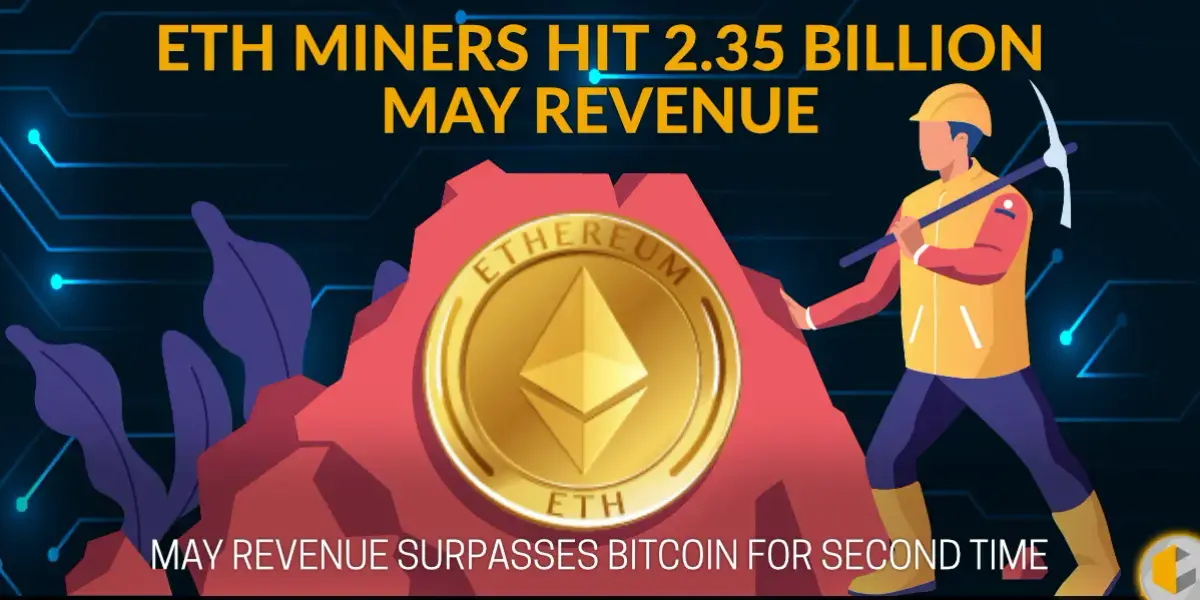
Last month, Bitcoin mining revenue fell behind Ethereum, with Ethereum miners earning more than Bitcoin miners for the second time in a year.
Figures for May, provided by Coin Metrics, show that monthly Ethereum blockchain mining revenue hit a record $2.35 billion, up 42.4 percent compared with the previous month. During the same time period, Bitcoin mining generated a total revenue of $1.45 billion.
Both Ethereum and Bitcoin employ the same data validation process known as Proof of Work to mine new coins. Proof of Work works by leveraging computational power to audit new transactions on the network. When a block of transaction data is successfully audited and proven to be accurate, it is added to the blockchain, and the miner is rewarded with the newly minted cryptocurrency.
Typically, Bitcoin mining dominates in terms of gross revenue, but Ethereum has reversed this pattern in the past. Mining revenue on Ethereum has narrowly beat out Bitcoin twice — once in 2017 and again in February, when income from Ethereum mining peaked at $1.37 billion to Bitcoin’s $1.36 billion.
Block rewards and their inclusive transaction fees are the two central sources of mining revenue. When someone mines a block of transactions and adds it to the blockchain, they receive all the transaction fees on that block, and are rewarded with a specific amount of new coins. Currently, this reward is 6.25 BTC ($246,000) every 10 minutes for Bitcoin, and two ETH ($5,750) every 13 seconds for Ethereum. On Ethereum, a miner can receive an additional 1.75 ether for an “uncle block” — a valid block containing transaction data mined at the same time as theirs.
Why is the difficulty increasing?
As more systems join the network, the difficulty of mining a single block increases, and the busier the network becomes, the more difficult it is to complete a transaction. Despite this, transaction fees continue to make Ethereum mining extremely profitable, as Ethereum’s profitability is driven not only by its price, but also by hefty transaction fees imposed on the overcrowded network.
In May, Ethereum’s average transaction fees skyrocketed, reaching a record high of $70 per transaction. Driven by unprecedented levels of network traffic and an all-time high price that saw one Ether trading for over $4,000, Ethereum miner revenue from transaction fees alone surpassed $1 billion — a 43.9 percent increase from April. Bitcoin transaction fees, on the other hand, only brought in about $130 million in revenue for miners.
Since then, the token has dropped 41% and is now trading around $2,700. Transaction fees decreased as a result, falling by 93 percent in less than two weeks. Furthermore, Ethereum’s eventual transition to a Proof-of-Stake procedure and the looming “London” hard fork (EIP-1559) network upgrade are both expected to alter the future (and profitability) of Ethereum mining.
What is needed to fix the problem?
EIP-1559 is a proposal to improve Ethereum by reducing the amount of ETH in circulation. With this upgrade, transaction fees would be burned in lieu of serving as an additional reward for miners. The move may increase demand for the cryptocurrency by limiting supply, raising the fiat value of ETH.
Proof-of-Stake, on the other hand, has sparked the most debate among Ethereum miners. The switch to a Proof-of-Stake system would completely transform mining. Instead of relying on computational power, the network will only be validated by users “staking”, or depositing, ETH into it. If they correctly validate blocks of transactions, they’ll receive new tokens, but if they don’t, they will lose a portion of their ETH.
The London hard fork, which is scheduled for July, will introduce the first iterations of these features to the Ethereum network. Ethereum’s users would see more stable transaction fees as a result of these anticipated network updates. However, the changes may weaken the odds of another record-breaking month of profits for Ethereum miners.
Editor-in Chief
Related Posts






Subscribe to our newsletter!
Information



